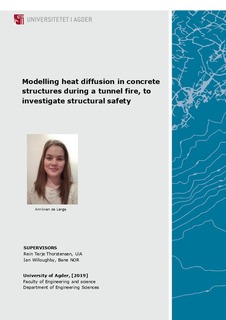| dc.contributor.author | Lange, Annikken de | |
| dc.date.accessioned | 2019-09-17T11:06:07Z | |
| dc.date.available | 2019-09-17T11:06:07Z | |
| dc.date.issued | 2019 | |
| dc.identifier.uri | http://hdl.handle.net/11250/2617182 | |
| dc.description | Master's Thesis Civil and Constructional Engineering BYG508 - University of Agder 2019 | nb_NO |
| dc.description.abstract | Thisismymaster’s thesis for my master’s degree in civil engineering.In this study,the heat diffusion in concrete structures during a tunnel fire is investigated. The available literature on the heat diffusion of the ISO 834, EUREKA 60, 90 and 120, HC and RWS fire curve have been investigated and compared. The fire curves are also modelled in the software ANSYS, where different approaches have been simulated,and temperature profiles have been established. The different analyseshavebeen developed and performed from a literature study, watching tutorials online and through meetings with experts. The importance of including all three heat transfer processes emerged through the study. The 1D-modelbased on elements with properties for conduction, convection,and radiation corresponded well with the temperature profiles presented in Eurocode 2, which indicates that the model is adequate for comparison. The material properties of concrete are considered,and the fire is simulated asa gas-temperature load. The different fire curves seem to influence the heat diffusion by the maximum achieved temperature, the steepness of the curve, the duration of the fire,and the cooling stage. The RWS fire curve is the fire curve that achieved the highest heat diffusion in the concrete. If the ISO 834 fire curve is assumed for a fire duration of 240 minutes,the heat diffusion will be higher than theheat diffusion of the EUREKA 120 fire curve. | nb_NO |
| dc.language.iso | eng | nb_NO |
| dc.publisher | Universitetet i Agder ; University of Agder | nb_NO |
| dc.rights | Attribution-NonCommercial-NoDerivatives 4.0 Internasjonal | * |
| dc.rights.uri | http://creativecommons.org/licenses/by-nc-nd/4.0/deed.no | * |
| dc.subject | BYG508 | nb_NO |
| dc.title | Modelling heat diffusion in concrete structures during a tunnel fire, to investigate structural safety | nb_NO |
| dc.type | Master thesis | nb_NO |
| dc.subject.nsi | VDP::Teknologi: 500::Bygningsfag: 530::Bygg-, anleggs- og transportteknologi: 532 | nb_NO |
| dc.source.pagenumber | 67 p. | nb_NO |

